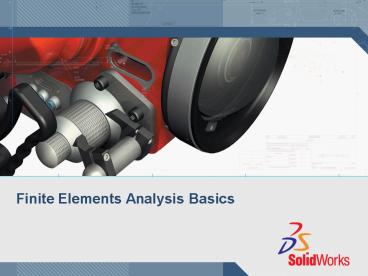Finite Elements Analysis Basics - PowerPoint PPT Presentation
1 / 13
Title:
Finite Elements Analysis Basics
Description:
Finite Elements Analysis Basics Analysis Foundation In designing the gear shafts below, what quantities would we examine? Stress Strain Displacement Rotation ... – PowerPoint PPT presentation
Number of Views:143
Avg rating:3.0/5.0
Title: Finite Elements Analysis Basics
1
Finite Elements Analysis Basics
2
Analysis Foundation
- In designing the gear shafts below, what
quantities would we examine? - Stress
- Strain
- Displacement
- Rotation
- Temperatures
3
Analysis Foundation
- In designing a valve, burner, or heat sink, what
quantities would we examine? - Pressure drop
- Temperatures
- Mass flow rate
- Velocities
- Fluid mixing
4
Analysis Foundation
- Hand calculations are easily applied to simple
geometries. - Cylinders
- Blocks
- Beam structures
- They are not easily or accurately applied to
general (complex) shapes.
? To analyze complex shapes we break them into
many simple shapes and compute the combined
response.
5
FEA Analogy Area
- Suppose we want to compute the area of a generic
shape.
6
FEA Analogy Area
- What do we do to improve the accuracy of the area
measurement?
7
FEA Mesh
- The pieces we divide the model into are called
ELEMENTS. Equations are generated for each
element. These are combined into a system of
equations for the entire structure. Matrix
algebra is used to solve the system of equations.
8
FEA Mesh Elements
- Each element is a simple solid.
- Elements are connected together at locations
called NODES.
9
FEA Mesh Elements
- A BRICK element model often must be created
MANUALLY. - A TETRA element can be created AUTOMATICALLY.
10
Brick Elements vs. Tetra Elements
- Brick Models
- Usually have many fewer elements than a Tetra
model (Quicker Solution). - - Time-consuming to generate.
- - Very difficult to create a brick model for
complex parts. - Tetra Models
- Quick to generate the model (with Automatic
meshing). - The same accuracy can be achieved as with
Bricks. - Can mesh very complex parts.
- - Usually have more elements than a Brick model.
11
Brick Elements vs. Tetra Elements
12
Brick Elements vs. Tetra Elements
13
Analysis Accuracy
- Fewer elements will solve more quickly.
- More elements will be more accurate.
- You need to strike a balance between model size
and run time.
14
Accuracy vs Mesh Size
15
Accuracy vs Mesh Size
16
Mesh Transition
- Many times different locations in the model do
not require the same accuracy. - Use mesh control and transition capabilities to
focus the computational effort in the areas where
the most accuracy is required.
17
Design Analysis Steps
- Geometry definition.
- Define component materials.
- Define physical situation with boundary
conditions. - Mesh the model.
- Run the analysis (solve the system of equations).
- View and evaluate the results.































